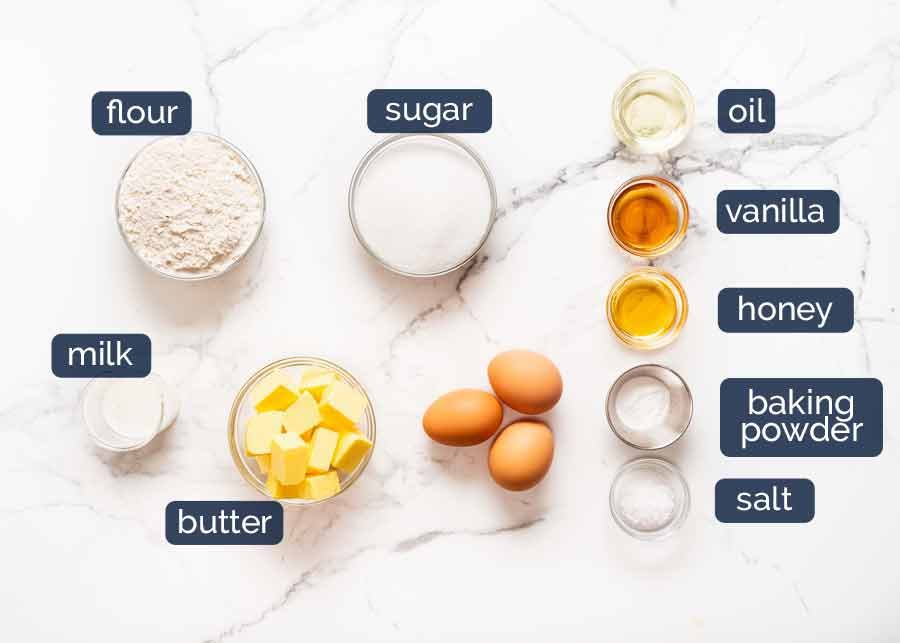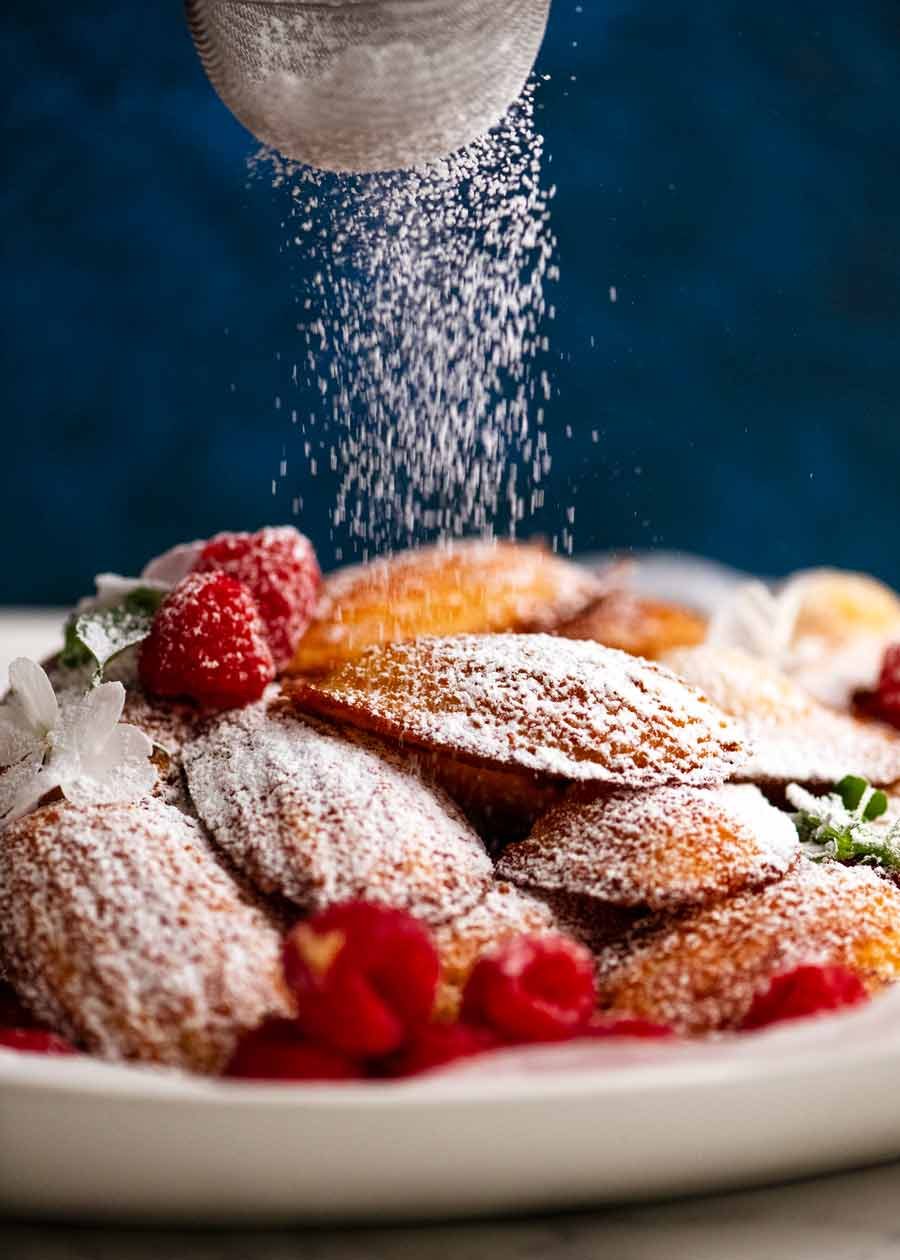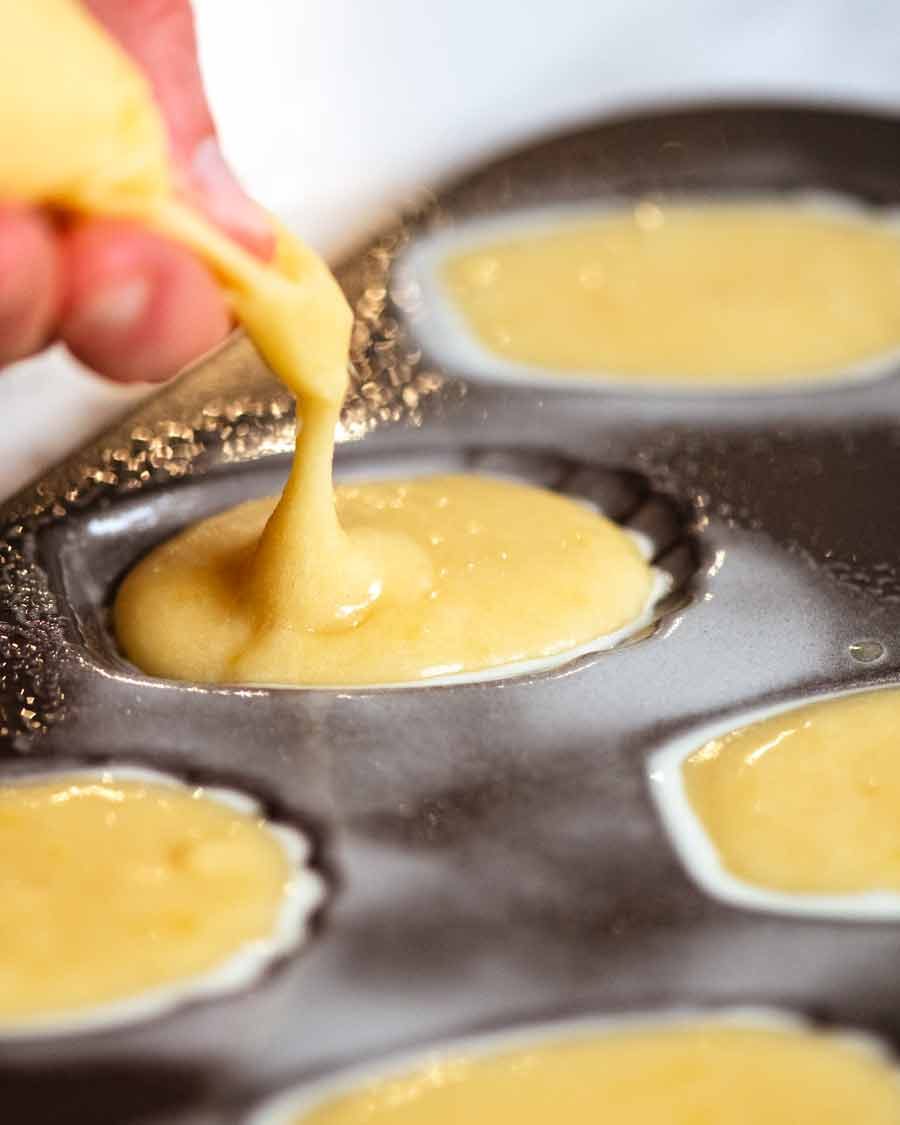Madeleines are petite, bite-sized French sponge cakes that are as delightful to the eye as they are to the mouth. Flavoured with a hint of lemon, these adorable mini-butter cakes are gorgeously tender. With their signature shell shape they make for a lovely afternoon tea or a pretty finish to any meal!

Madeleines
It’s another classic French baking recipe courtesy of Chef Jean-Baptiste! Boy was he determined to get this one just perfect. The reputation of his motherland is on the line here, after all!!
There were many, many Madeleines made in the quest to perfect this recipe and find answers to all the what-ifs in the making. We aren’t fussy around these parts… not at all!😂
So what makes a perfect Madeleine, according to a French chef?
-
A tender, elegant crumb with fine, delicate holes. Not large, crude, irregular-sized holes. We aren’t making sourdough here!
-
It is soft and moist on the inside while just-crisp on the edges;
-
There’s a signature, plump doming shape in the middle. This is a sign of a well-baked Madeleine!
-
It’s buttery in a melt-in-your-mouth way, not a greasy way.
-
It’s sweet but not overly so, and flavoured with the lightest touch of citrus; and
-
It’s a light golden colour on the top, and a deeper golden on the underside with the distinct, signature shell grooves.
I think we got to Madeleine #226 before he finally conceded that Batch #1 was indeed the best. Isn’t it always the way? 😂
-

-

Impossible to capture how melt-in-your-mouth these are. Just make them for yourself!

(PS. Chef JB also wants me to pass on that you might find Madeleines on the internet with bigger humps. However a bigger hump = thicker batter = drier Madeleines. It is all about finding the right balance, he says, ie. The best hump with the most moist crumb inside.👌🏻)

What you need for Madeleines
Here’s what you need to make Madeleines – though note that I accidentally left out lemon zest in this photo!!

-
Flour – Just plain flour / all purpose flour. Though I haven’t tried, self raising flour should work too (skip the baking powder);
-
Sugar – Caster / superfine sugar works best here because it dissolves more easily into the batter. However, granulated / ordinary white sugar will work ok too;
-
Baking powder – This is what makes the batter rise and makes the crumb beautifully light and fluffy.
Check baking powder is still good – If your baking powder has been sitting in the dark depths of your cupboard for a while, it’s best to check it’s still good – see here. Baking powder can be dead even if it’s not past the due date.
-
Eggs at room temperature – The eggs need to be at room temperature and not fridge-cold, to ensure it incorporates properly into the batter easily. A quick way to warm up fridge-cold eggs: Place eggs in a large bowl, cover with warm tap water (just warm, not hot) and leave for 5 min. Wipe dry, then use per recipe.
Egg size (“large eggs”): 50 – 55g / 2 oz per egg is the industry standard of sizes sold as “large eggs” in Australia and the US. If your eggs are significantly larger or smaller in size, just weigh different eggs and use 150-165g / 6 oz in total (including shell) or 135 – 150g / 5.4 oz in total excluding shell (useful if you need to use a partial egg to make up the total required weight. Crack eggs, beat whites and yolks together, THEN pour into a bowl to measure out what you need);
-
Butter – The butter is melted so no need to soften to room temperature;
-
Vanilla extract – Extract is better than essence which is artificial. Use the best you can afford, for the best flavour;
-
Honey – For a touch of flavour;
-
Lemon zest – A hint of citrus flavour is traditional, and it really does give them the perfect finishing touch!
-
Salt – A pinch of salt in sweet baked goods is always a good thing. You can’t (shouldn’t!) be able to taste the saltiness, it’s there to help bring out flavour.
How to make Madeleines
The traditional way to make Madeleines is to refrigerate the batter overnight which allows the batter to chill and thicken so when you bake them, you get the signature bump on the surface. You can even freeze the batter for 2 months!
Because of this, they make for a terrific treat to bake to order. Have the batter sealed in a piping bag. Then it literally takes 40 seconds to pipe them into the pan and pop them in the oven, then you’re just 10 minutes away from freshly cooked Madeleines! (Oh ok fine, it might take you 90 seconds, or 2 minutes. But you get my point – it’s fast!)
Part 1: The Madeleines batter

-
Sift flour: Sift the flour and baking powder into a bowl;
-
Whisk eggs and sugar: Whisk the eggs and sugar vigorously until it becomes pale and a bit foamy on the surface. This will take about 2 minutes by hand (and a bit of bicep strength!) or 1 minute on speed 6 with handheld beater;
-
Mix flour in 3 parts: Add the flour mixture in 3 parts, whisking gently in between until combined. Use a gentle touch here so we don’t over work the gluten which makes the crumb less tender;
-
Add everything else except butter: Add salt, oil, milk, honey, vanilla and lemon. Mix until combined.
-
Add butter: Add butter, mix gently with a rubber spatula until combined;
-
Goal batter: The batter is fairly thin but should leave a faint ribbon briefly on the surface, as pictured above (also see video);
-
Cover and refrigerate: Cover with plastic wrap touching the surface and leave it in the fridge overnight (minimum 6 hours). The purpose of this is to chill the batter which also thickens it. This is what creates the signature hump on the Madeleines – the shock of the heat hitting the cold batter, and the thicker batter which allows the cake to rise faster;
-
Ready to use: Remove the chilled batter from the fridge. Now it’s time to get it into a piping bag to make it easy to fill the pans!
Part 2: Baking

-
Fill piping bag with the batter, fitted with a small round nozzle. I fit the bag into a tall glass or my Nutribullet jug, then pour the batter in;
-
Refrigerate until required: Bags filled, it’s now ready to pipe into the pan. Or, if you want to bake them fresh on demand, just pop them into the fridge. You can even freeze them for up to 2 months!
-
Spray Madeleine pans: Spray the pans with canola oil or any other neutral flavoured oil. In case you’re wondering why we don’t brush with butter, it’s because it doesn’t grease it as well – some of the Madeleines will get a bit stuck. This is because butter is not pure fat, there’s dairy and water components in it (food trivia of the day!)
-
Pipe batter into the pan, filling it just shy of the top of the rim;
-
Bake: Bake for 10 minutes in a 200°C/390°F oven (180°C). The oven is hotter than you might imagine for delicate little sponge cakes like this because this is how you achieve the beautiful golden surface in such a short baking time, and the signature hump. As mentioned above, that hump is the sign of a well made Madeleine – so we want the hump!!
-
Ready to serve! The Madeleines are ready when they are golden on the surface and have the signature hump. Unmold straight away so they don’t continue cooking. Dust with icing sugar and serve immediately, while hot!


When and how to serve Madeleines
Ask the French, and they’ll tell you Madeleines are typically served for afternoon tea.
Ask me, and I’ll tell you there’s a place for Madeleines at any time of the day. Morning tea, afternoon tea, as a freshly-baked dessert after dinner (this was received extremely well in my case!) … like I said, any time!
And honestly, try telling me you could resist if I put a plate of these out at breakfast? Anyone who says they could is either made of stone – or a liar!😂 – Nagi x
Watch how to make it
Hungry for more? Subscribe to my newsletter and follow along on Facebook, Pinterest and Instagram for all of the latest updates.

Madeleines
#wprm-recipe-rating-0 .wprm-rating-star.wprm-rating-star-full svg * { fill: #343434; }#wprm-recipe-rating-0 .wprm-rating-star.wprm-rating-star-33 svg * { fill: url(#wprm-recipe-rating-0-33); }#wprm-recipe-rating-0 .wprm-rating-star.wprm-rating-star-50 svg * { fill: url(#wprm-recipe-rating-0-50); }#wprm-recipe-rating-0 .wprm-rating-star.wprm-rating-star-66 svg * { fill: url(#wprm-recipe-rating-0-66); }linearGradient#wprm-recipe-rating-0-33 stop { stop-color: #343434; }linearGradient#wprm-recipe-rating-0-50 stop { stop-color: #343434; }linearGradient#wprm-recipe-rating-0-66 stop { stop-color: #343434; }
Ingredients
- 3/4 cup + 1 tbspplain flour (all purpose flour)
- 1 1/4tspbaking powder(make sure it’s still good)
- 3large eggs, at room temperature (Note 1)
- 2/3cupcaster sugar (superfine sugar)(ordinary / granulated sugar ok too)
- 1tspsalt
- 1tbspvegetable oil(or other neutral oil)
- 3tbspmilk, full fat (low fat ok too)
- 2tsphoney(or maple syrup)
- 2tspvanilla extract
- 2tsplemon zest
- 135g / 9.5 tbspunsalted butter, melted, warm (not hot)
- Canola oil spray(or other neutral oil)
- Icing sugar / powdered sugar(optional, for dusting)
Instructions
-
Sift flour: Sift the flour and baking powder into a bowl.
-
Whisk eggs and sugar: Whisk the eggs and sugar vigorously for 2 minutes until it becomes paler in colour and it’s foamy (or 1 minute on speed 6 with handheld beater).
-
Mix flour in 3 parts: Add the flour mixture in 3 parts, whisking gently in between until combined.
-
Add everything else except butter: Add salt, oil, milk, honey, vanilla and lemon. Mix until combined.
-
Add butter: Add butter, mix gently with a rubber spatula until combined. The batter is fairly thin but should leave a faint ribbon briefly on the surface (see video).
-
Cover and refrigerate: Cover with plastic wrap touching the surface and leave it in the fridge overnight (minimum 6 hours).
Baking (next day):
-
Preheat oven to 200°C / 390°F (180°C fan) for at least 30 minutes.
-
Piping bags – Pour the madeleine batter into 2 piping bags (or 1 large) either fitted with a round tip nozzle around 0.7 – 1.2cm (0.3 – 0.5″) wide, or snip the end off. (You can refrigerate until required at this stage, or freeze 2 months).
-
Spray and fill pan: Spray the madeleine pan with oil. Fill each hole almost to the top (2just 1m from the rim).
-
Bake: Bake for 10 minutes until light golden.
-
Serve warm! Unmold straight away. Pile onto serving platter. Dust with icing sugar and serve immediately, while hot!
Recipe Notes:
Nutrition Information:
Life of Dozer
That sweet buttery smell….






